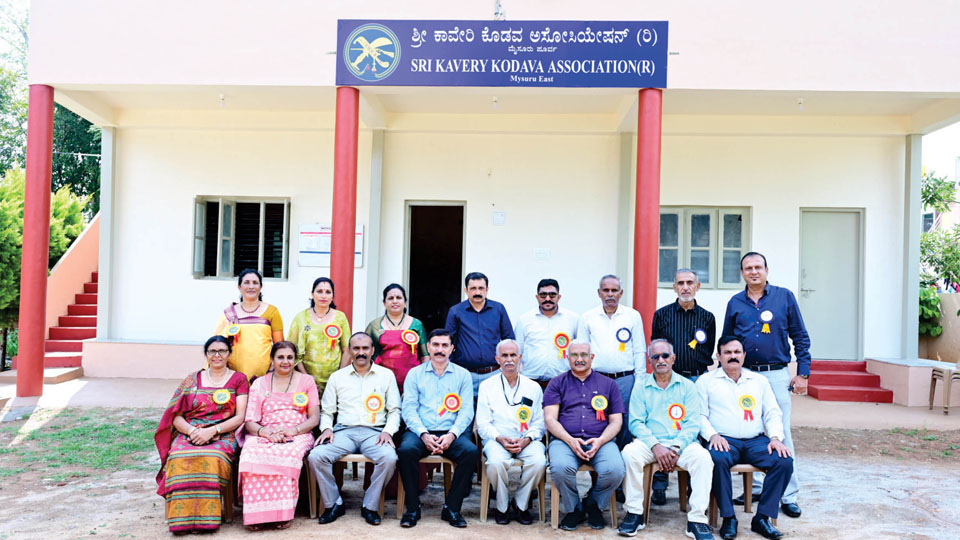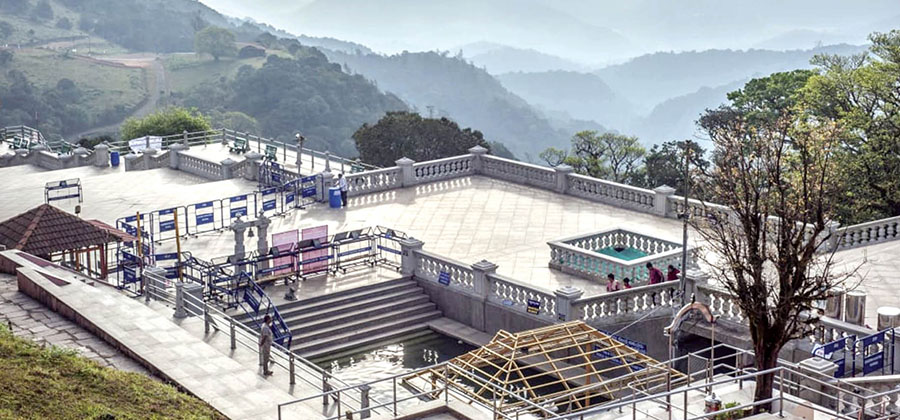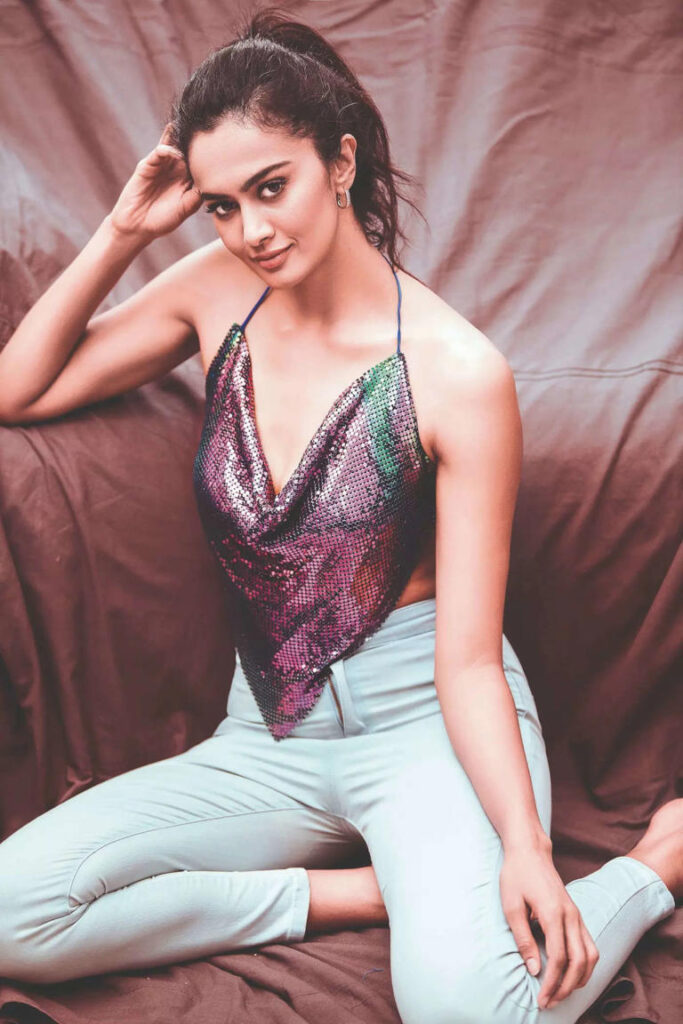Legend says that when Goddess Kaveri left Agasthya, the force of her current turned around the pleats of Kodava women’s saris.

A Kodava bride (image courtesy: YouTube)
The mystery of the Kodavas
The source of the sacred river Kaveri is in Kodagu (Coorg) on the eastern slopes of the Western Ghats. Kodagu’s beautiful landscapes of thickly forested slopes, monsoon-fed streams, and abundant native flora and fauna are home to the Kodavas, a unique community with a martial lineage and customs that differ from their neighbors. The origins of the Kodavas who are primarily ancestor and nature worshippers remain shrouded in mystery – theories speculate they descended from a lost platoon of Alexander the Great’s soldiers or pre-Islamic Kurds who traveled from the present Turkey, Iran, and Iraq. None have been proven satisfactorily!
What sets the Kodavas apart from their southern neighbors is their traditional clothing. Men wear long black coats called kupsas, while women wear sarees draped quite differently from the traditional Indian style. This attire is best reflected at a Kodava wedding where, along with very distinctive jewelry, Kodava men and women showcase their unique cultural heritage and values.

A Kodava bride (image courtesy: YouTube)
The Legend of Kaveri
In Coorg, legend says that when an irate Kaveri left her husband the sage Agasthya, the Kodavas implored her to stay. She was adamant about leaving but promised to always remain with them in the form of a river, nourishing their land and giving them sustenance. When Kaveri left, the force of her current turned the pleats of the Kodava women’s saris around. To date, Kodava women wear their saris with the pleats behind, and one end wrapped under their left arm and pinned over the right shoulder.

How to drape a Kodava sari (image courtesy: Youtube)
Kodava brides wear their saris this way, with a long-sleeved blouse and a veil called a musku; elaborate Benarasi silks embroidered with motifs, in shades ranging from red to magenta are the preferred option. It is customary for a bride to wear either her mother’s or grandmother’s sari, most of which are preserved carefully over the years.
Our family to date uses my great-grandmother’s veil; tissue thin and delicate, yet surprisingly strong, and witness to many family weddings.

A Kodava bride (image courtesy: Shonali Madapa)
Inspired by nature
Kodava jewelry is inspired by nature – it is common to see patterns and designs representing the sun, moon, the serpent, flora and fauna, and in one instance specifically, the prickly skin of a jackfruit.
The jewelry is typically hollow, characterized by delicate repousse work–a method in which the metal is beaten from the inside into a desired shape or pattern. Gold studded with precious stones is primarily the metal of choice; silver is used only for the hands and feet.
What does stand out though is a clear design influence from an entirely different region. This remains as much of a mystery as are the origins of the Kodavas. The kokkethathi, a crescent-shaped pendant inspired by the moon, does bear a similarity to a pendant found in Oman, as does the peechai kathi, similar to the traditional daggers worn by Omani men. Perhaps this lends credence to one of the many theories on the origins of the Kodavas–a tribe who migrated to India many centuries ago, from the Middle East via land and sea.
Kodava Brides: The Sacred Seven
Tradition dictates Kodava bridal jewelry. Considered a tribute to the seven rishis who did penance at Talakaveri in ancient times and to receive their blessings, Kodava brides of yore wore seven ornaments on their hair, seven earrings, seven chains around the neck, seven bangles and bracelets on their hands and seven ornaments for their feet. Modern Kodava brides do wear similar traditional jewelry, but it is increasingly rare to find a bride who wears all seven required ornaments.

Kodava bridal jewelry (image courtesy: YouTube)
The bride wears a pendant on her forehead with seven gold ornaments of diminishing sizes decorating her braid. The most striking is a crescent-shaped pendant representing the moon. She wears chandelier earrings known as jhumkas in gold, studded with diamonds, rubies, and pearls, with gold chains linked to her hair.
Her seven necklaces include the pathak – a gold coin set with corals, surmounted by a serpent head, symbolic of fertility; the paavale maala – a coral and gold necklace her mother places on her neck the evening before the wedding, and the joomale – a necklace of finely crafted gold beads strung on black thread. She also wears the kokkethathi – a unique crescent-shaped pendant on a chain, the showstopper of all her jewelry. The crescent is surmounted by the head of a serpent, a figure of Goddess Lakshmi, and two birds. A row of descending cabochon rubies and a string of hanging pearls on the edge, complete the design. This pendant bears an uncanny resemblance to the ‘boat’ design that occurs frequently in classical Greek jewelry of the 4th and 5th century BC.
Other jewels such as the adige – a ruby choker with a matching pendant, the paunsara or a chain of gold coins, and the chengole – a thick gold chain, complete the set of ornaments around her neck.
Tradition and grace
On her hands, the bride wears numerous traditional bangles known as kadagas; most are oval and not circular in shape, as a result of which they fit the wrist better. The pimbale is worn first, followed by the jodi kadaga (which appears to be inspired by bamboo and its distinctive nodal points on the stem), and the paunchi, a spiky bracelet inspired by the jackfruit, interspersed with numerous red and black glass bangles and other gold bracelets.

Kodava bridal jewelry (image courtesy: YouTube)
The most fascinating pieces of Kodava bridal jewelry are the silver bracelets and anklets called the kaisara and the kaalpili. Both these ornaments have characteristic rings attached to delicate silver chains that link to a bangle around the wrist or ankle. The intricacy of the design adds to the overall grace that the bride exudes.

A Kodava bride’s silver anklets (image courtesy: Shonali Madapa)
The Kodava bride’s attire is both practical and alluring, a throwback to earlier days when people had to walk long distances through dense forests and perhaps face unexpected attacks from rival clans or wild animals. With her pleats safely out of the way and all corners of the sari pinned in place, the Kodava sari allows unhindered movement and embodies the traditional Kodava way of life, both spirited and practical.
Kodava bridegrooms. Of kupsas, knives, and knotted sashes.
Like his bride, centuries ago, a Kodava bridegroom may have had to fend off rivals or wildlife as he walked long distances from his okka (patrilineal clan home) through dense forests, to the house of his bride and back. The trip was fraught with danger. The bridegroom as well as the males in his party had to be well equipped to deal with this. Consequently, weaponry formed a critical part of the bridegroom’s attire.
The present-day attire of a Kodava bridegroom reflects this aspect of the Kodava’s martial tradition. Knives and a pointed staff were and still are an intrinsic part of a bridegroom’s outfit. Over a long white coat called a kupsa, the bridegroom wears a richly embroidered red brocade silk sash – a chale – around his waist and a thick band of gold or silver on one wrist. His headgear is complemented by a red silk scarf.

A Kodava bride and groom (image courtesy: Shonali Madapa)
Tucked into the front of the sash is a curved knife known as the peechekathi, sheathed in a beautifully ornamented case. Typically, peechekathis are family heirlooms handed down from generation to generation. The sheath, made from silver, ivory, teak, or ebony elaborately embellished with patterns of gold and silver is attached to a silver chain with a thick silver tassel hooked behind to the sash with a small silver disc. From the disc hang several delicately crafted miniature objects including a gun, the Kodava war knife, an ear-pick, and a toothpick. Solely representative of practical and martial traditions, these objects fortunately are not used in public.

A traditional peeche kathi, handed down over generations.(image courtesy: Shonali Madapa)
A heavy thodang or a metal clasp of bronze or silver fixed to the back of the bridegroom’s waist holds the odi kathi, the large Kodava war knife. The bridegroom also carries a waist-high wooden staff called the gejje thande made from ebony, decorated with bands of silver and small bells. The staff ends in a lethal metal point which doubles as a weapon.
The bridegrooms proxy
A unique and less widely known feature of the thande is that it can stand in as proxy for the bridegroom if he cannot be physically present at the wedding. This centuries-old custom reflects the martial heritage of the Kodavas. A man could suddenly be called away to battle, in which case the thande would be carried by the bojakara (best man) to the bride’s home so that ceremonies could proceed.
The bojakara is normally a closely related male who mentors and assists the bridegroom through the wedding ceremonies. Kodava weddings are normally a two-day affair with various rituals performed simultaneously at the bride and bridegroom’s respective okkas, before the final murtha – an auspicious ceremony where a gathering of family, clan members, and community assembles to bless the couple.
Men in Black
If you are invited to a Kodava wedding, besides the resplendent array of dazzling silk sarees worn by the women, be prepared for the men in black. Attired in black kupsas with chales and peechekathis, they provide a striking contrast to the sole wearer of the white kupsa–the bridegroom at his martial best.

The thodang, a heavy metal clasp which holds the odi kathi (a traditional Kodava war knife), placed at the back of the bridegroom’s waist (image courtesy: Shonali Madapa)
What’s most striking about Kodava jewelry, is its intricate and clever use of geometric forms and shapes–the building blocks of any good design vocabulary. Walk down any bye lane of a town in Coorg and you might stumble on a master craftsman, ever willing to show you a craft that has been practiced for centuries.
A version of this story first published on evolveback.coorg.
source: http://www.indiacurrents.com / India Currents / Home> Culture> Heritage> Lifestyle> Tradition / by Shonali Madapa / October 15th, 2024
